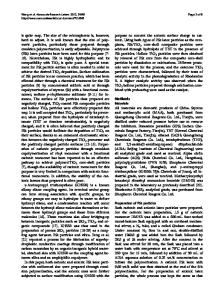Simultaneous deposition of Au nanoparticles during flame synthesis of TiO 2 and SiO 2
- PDF / 204,428 Bytes
- 6 Pages / 612 x 792 pts (letter) Page_size
- 48 Downloads / 375 Views
nostructured gold/titania and gold/silica particles with up to 4 wt% Au were made by a single-step process in a spray flame reactor. Gold(III)-chloride hydrate and titania- or silica-based metalorganic precursors were mixed in a liquid fuel solution, keeping concentrations in the flame and overall combustion enthalpy constant. The powders were characterized by x-ray diffraction, transmission electron microscopy, Brunauer–Emmett–Teller, and ultraviolet–visible analysis. The titania or silica specific surface area and the crystalline structure of titania were not affected by the presence of gold in the flame. Furthermore the size of the gold deposits was independent of the metal oxide support (TiO2 or SiO2) and its specific surface area (100 and 320 m2/g, respectively). The gold nanoparticles were nonagglomerated, spherical, mostly single crystalline, and well dispersed on the metal oxide support. Depending on the Au weight fraction (1, 2, and 4 wt%) the Au nanoparticles’ mass mean diameter was 3, 7, and 15 nm, respectively, on both titania and silica. The particles showed surface plasmon absorption bands in the ultraviolet–visible region, which is typical for nano-sized gold. This absorption band was red shifted in the case of the titania support, while no shift occurred with the silica support.
I. INTRODUCTION
The preparation of fine metal particles on oxides plays a crucial role in determining product properties of a wide range of materials used in optics, catalysis, electronics, and ceramics. In general, such metal particles are prepared by wet precipitation of the metal on a support and by co-precipitation or by two-step processes in which metal and ceramic supports are made separately, such as sputtering, chemical vapor deposition, and grafting or impregnation.1–4 A particularly attractive route for synthesis of highly pure materials (e.g., lightguides for telecommunication) is flame aerosol technology, which can also be used for synthesis of metal–ceramic nanoparticles.5 Direct aerosol synthesis of gold nanoparticles (aerosol) was introduced recently by Magnusson et al.6 and Nakaso et al.7 using an evaporation/condensation process in a tube furnace reactor. They investigated sintering and restructuring mechanisms of gold particles theoretically and experimentally. The mobility diameter of the gold particles was controlled from about 10 to 30 nm with the temperature of the furnace. A one-step aerosol synthesis of a supported noble metal on a metal oxide (Pt /TiO2)
a)
Address all correspondence to this author. e-mail: [email protected] J. Mater. Res., Vol. 18, No. 1, Jan 2003
http://journals.cambridge.org
Downloaded: 28 May 2014
was proposed by Johannessen and Koutsopoulos8 who fed and simultaneously combusted Ti-isopropoxide and platinum acetylacetonate [Pt(acac)2] vapors in a quenchcooled flame reactor. The product powder consisted of aggregated titania with Pt particles of about 2 nm. However, when this vapor flame approach was used, all precursors had to be evaporated before entering the reacti
Data Loading...











